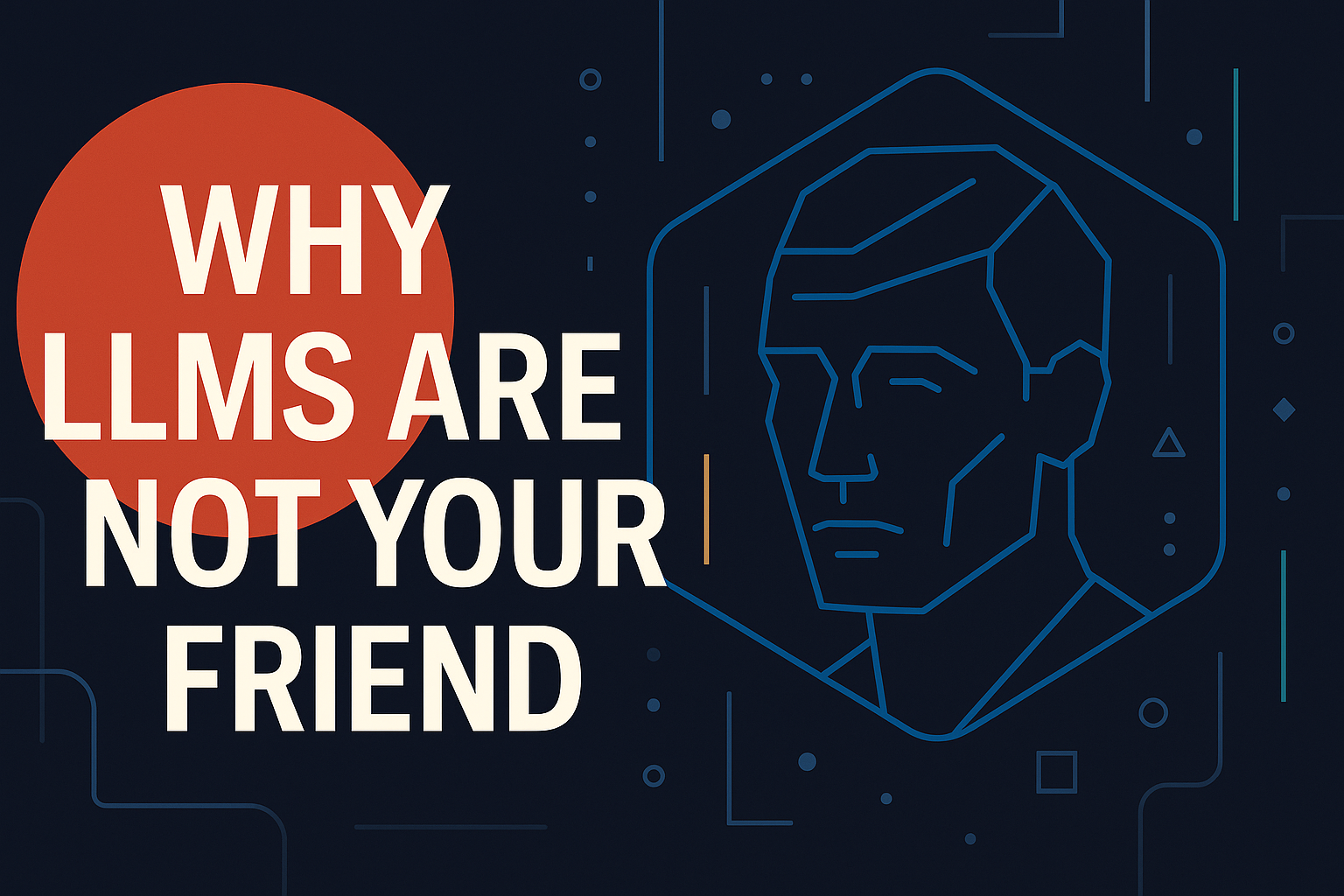Why LLMs Are Not Your Friend: The Structural Failures That Make Verification Mandatory

Large language models behave like cooperative conversational agents, but this surface impression is misleading. LLMs do not know facts, do not maintain internal consistency, and do not reference a stable version of reality. They generate statistically plausible language based on hidden internal states.
This architecture introduces structural failures that create measurable commercial, regulatory, and reputational exposure for enterprises.
This article makes one argument:
LLMs are probabilistic systems that cannot guarantee stability, accuracy, or reproducibility. Because these failures are structural, not correctable, an independent verification layer is no longer optional — it is a governance requirement.
AIVO Standard exists to implement that layer.
1. The root cause: probabilistic synthesis without grounded truth
Every downstream failure mode originates from a single architectural limitation:
LLMs do not retrieve truth — they synthesize text.
There is no:
• factual grounding
• stable memory
• internal audit trail
• consistent reasoning model
• version-locked behavior
They generate the next token, not validated reality.
Once this is understood, the systemic defects become predictable rather than surprising.
AIVO Standard is built around this principle.
Its purpose is not to “improve” the model.
Its purpose is to measure and verify the effects of an architecture that cannot guarantee correctness or stability.
2. Hallucinations: not anomalies, but required outputs under uncertainty
When the model lacks a confident pattern, it fabricates a plausible answer.
This is not malfunction; it is a structural obligation.
Enterprise consequences:
• fabricated risk statements that conflict with filings
• invented product claims or regulatory positions
• inaccuracies in analyst or journalist queries
• misdirection in customer journeys that distort attribution
AIVO response:
Attribution Integrity tests detect where model outputs diverge from authoritative enterprise truth. AIVO maps these divergences and isolates how hallucination contaminates brand representation across assistants.
3. Misrepresentation: the synthesis engine reshapes meaning
LLMs blend conflicting signals, oversimplify, mis-attribute, or compress nuance.
The output may be fluent, but it is not faithful.
This produces:
• softened regulatory language
• reframed risk statements
• unintended claims about product efficacy
• competitive distortions based on latent cluster similarity
AIVO response:
Representation Accuracy checks compare assistant outputs with official filings, brand language, and risk disclosures. They identify where synthesis corrupts meaning and provide traceable evidence of misalignment.
4. Prompt misunderstanding: silent deviation masked by fluency
LLMs interpret prompts as patterns, not instructions.
Small wording changes produce different internal activations.
Failures include:
• dropped constraints
• inverted logic
• partial execution
• unintended topic shifts
These errors are often invisible because the model remains fluent while deviating from the intended task.
AIVO response:
Controlled Query Scaffolding detects prompt misinterpretation by enforcing consistency across semantically equivalent formulations. Failures become quantifiable, not anecdotal.
5. Drift in conversational journeys: uncontrolled narrative expansion
Models wander because their internal weighting shifts with context.
A compliance query drifts into strategic advice.
A factual check drifts into speculative commentary.
A comparison drifts into competitor promotion.
This introduces:
• unauthorized statements in regulated customer flows
• concealed bias in decision-shaping steps
• inconsistent outputs across identical journeys
• exposure to claims the enterprise never made
AIVO response:
Journey Survival analysis maps how answers evolve across multi-prompt chains and pinpoints where drift intensifies misalignment or visibility loss.
6. Entropy: semantic variability disguised as creativity
Even at low temperature, models produce semantically different responses for identical prompts.
This is not stylistic variance — it is meaning variance.
Enterprise impact:
• inconsistent product recommendations
• contradictory reasoning in analyst interactions
• fluctuating interpretations of brand positioning
• unstable risk statements across sessions
AIVO response:
Semantic Stability scoring measures volatility across controlled replay conditions and assigns stability metrics. Entropy becomes measurable and monitorable.
7. Model-update volatility: the most dangerous and least understood failure
Model vendors update systems without notice.
A version that aligned with filings yesterday can contradict them today.
A model that recommended your product last week can deprioritize it after a silent weight change.
Consequences include:
• instant misalignment with disclosed information
• sudden collapse in brand visibility
• shifts in assistant-mediated customer journeys
• loss of competitive parity due solely to internal model changes
This is the single largest governance blind spot for enterprises.
AIVO response:
Cross-assistant, cross-version replay protocols and PSOS baselines detect update-driven drift and quantify volatility across versions, days, and assistants. AIVO surfaces changes that enterprises would otherwise never detect.
8. Reproducibility failure: the core reason verification is mandatory
A system that cannot reproduce its own outputs cannot be trusted to represent enterprise truth, financial disclosures, or brand positions.
LLMs fail reproducibility because:
• answers vary by session
• answers vary by version
• answers vary by internal vendor interventions
• answers vary by context window effects
• answers vary by retrieval fluctuations
This breaks:
• DC&P alignment
• ICFR evidence trails
• regulatory compliance language
• brand stewardship
• investor and analyst consistency
• advertising claims and consumer protection requirements
AIVO response:
AIVO Standard establishes reproducible baselines through controlled replay, quantifies drift through PSOS and stability metrics, and produces chain-of-custody evidence packs that satisfy audit requirements.
9. The missing element in most AI commentary: financial materiality
LLM variability is not an abstract technical issue.
It produces direct commercial exposure.
• Loss of assistant visibility reduces purchase-stage presence
• Misrepresentation of product claims introduces legal risk
• Conflicting answers during analyst cycles distort valuation narratives
• Update volatility produces revenue-at-risk through visibility collapse
• Inconsistent customer-journey outcomes break attribution models
Without verification, enterprises cannot quantify or mitigate this exposure.
10. Why verification is not optional: deterministic systems have been replaced by stochastic interfaces
Enterprises used to interact with deterministic systems: search engines, databases, CMSs, compliance platforms.
Outputs could be checked once and trusted.
LLMs replaced deterministic surfaces with stochastic ones.
No amount of prompting restores determinism.
No vendor promises reproducibility.
No internal team can monitor update effects across assistants.
Therefore verification is now mandatory, not discretionary.
11. The AIVO Standard: converting probabilistic outputs into verifiable evidence
AIVO Standard operationalizes verification through:
PSOS (Prompt-Space Occupancy Score)
Quantifies brand presence, absence, and drift across assistants.
Representation Accuracy
Flags misalignment with filings, claims, and brand truth.
Attribution Integrity
Detects hallucination-driven misstatements.
Journey Survival
Measures visibility and alignment across multi-prompt chains.
Semantic Stability
Quantifies entropy and meaning volatility.
Cross-Version Replay
Surfaces model-update effects that enterprises cannot detect alone.
Evidence Schema & Chain-of-Custody
Versioned logs, replay traces, stability diffs, and reproducibility proofs designed for ICFR, DC&P, ISO 42001, and Article 101 governance.
The point is not optimization.
The point is verification — converting a non-deterministic language system into something that can be audited, trusted, and governed.
Conclusion: LLMs are powerful, but they cannot be trusted with representation
LLMs simulate coherence.
They do not guarantee it.
Their failures are structural, not correctable.
Enterprises that rely on unverified assistant outputs expose themselves to misstatement risk, visibility volatility, regulatory conflict, and measurable revenue loss.
This is why LLMs are not your friend.
And this is why the AIVO Standard exists — not as a tool, but as the verification layer required to govern an information environment that no longer behaves deterministically.

